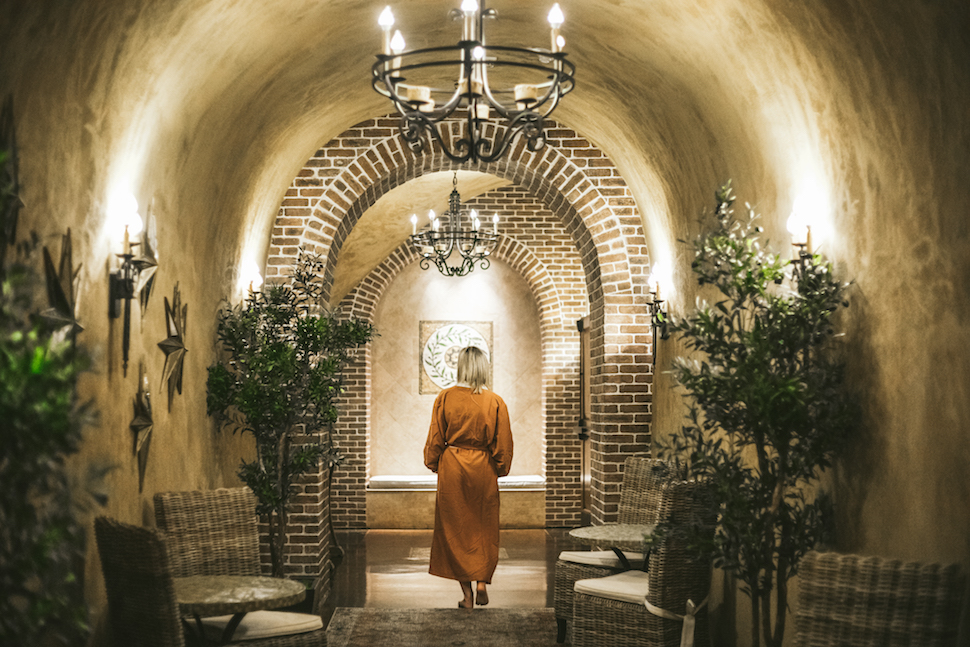
As a psychotherapist, I hear it. The everyday groan of the socially distanced on Zoom; the too-muchness and not-enough-ness of personal and professional lives in lockdown; the overbearing remoteness of remote learning at home, the 24/7 of Home Alone-Together; the persistent wish to feel closer, but with just a little privacy . . . please?!
In dealing with stress in the pre-Covid-19 world, one might simply run to a massage therapist for relief. However, the knots that people want relieved at a spa can often tighten, as clients weigh concerns of safe-enough touch in the age of Covid-19. Nowadays, a fragrant steam and a 120-minute deep tissue massage might feel downright dangerous—even when social distancing, glove and mask-wearing protocols are observed. Despite these measures, every minute of what should be a blissful massage could be experienced as fraught with fear of contracting the virus—and who needs that!
When a healing spa treatment starts to feel risky—how do you address your risk tolerance? How do you assess what looking out for your wellbeing looks like? Maybe a little “exposure therapy,” a cognitive-behavioral approach is in order. If you had a case of “acrophobia,” or fear of heights, you could simply avoid those situations that escalate your fear, or you could do the work of tackling the fear.
Avoidance for an acrophobic would be always opting for the train or a car instead of an airplane, despite the convenience of the latter.
When a healing spa treatment starts to feel risky—how do you address your risk tolerance?
Engaging the Fear
One would act with the fear of heights by dosing it out, engaging it. Doing the work would sound like: “I’ve had it with this fear, I don’t want it to control me. I am going to climb the ladder of my fear—one step at a time.” An antidote to acrophobia would be to acclimate to higher places, perhaps stairwell by stairwell taking in the vistas with calming breaths, soothing oneself, until one felt some mastery over the fear. For most of us, overcoming a fear is in the doing, not so much in the thinking. Change your behavior, and the thinking starts to change as well.
But with a spa, in the times of Covid-19, it’s tempting to skip the whole thing—arguably a massage is not a necessity. But then missing it, may not be the healthiest way to work with fear. Maybe you go for a short spa treatment, stay away from a steam or a facial which many spas are not offering anyway.
Creating Comfort & Open Communication
 Spas such as Spa Terra in Napa Valley, presently do not offer treatments more than 80 minutes. The idea is that less can be more comforting these days—kind of an “exposure therapy” mindset. According to Alison Abbott, Director of Spa and Wellness at the Meritage Resort’s Spa Terra, outdoor cabana massages are a big hit, offering the protective factor of fresh, circulating air to boost the trust factor. The conscious theatre of masks, visors, sanitizers, social distance, etc., communicate exquisite care and encourage people to relax. It is a powerful visual cue that you are being protected. When clients are indoors, there is a 30-minute interval between appointments and estheticians are bound to the specific rooms—cutting down on the number of people who visit a room.
Spas such as Spa Terra in Napa Valley, presently do not offer treatments more than 80 minutes. The idea is that less can be more comforting these days—kind of an “exposure therapy” mindset. According to Alison Abbott, Director of Spa and Wellness at the Meritage Resort’s Spa Terra, outdoor cabana massages are a big hit, offering the protective factor of fresh, circulating air to boost the trust factor. The conscious theatre of masks, visors, sanitizers, social distance, etc., communicate exquisite care and encourage people to relax. It is a powerful visual cue that you are being protected. When clients are indoors, there is a 30-minute interval between appointments and estheticians are bound to the specific rooms—cutting down on the number of people who visit a room.
The etiquette of “checking in” is a powerful tool in creating a healing environment for spa clients. In the world of social distance, words are a powerful contact experience. While protocols are maintained, what happens in the air—in the spoken word between client and esthetician/spa staff—is what touches a client first, and helps them feel cared for and safer, so that they can be touched physically.
That is the feeling clients want to experience before anyone gets close to touching them. The art of “checking in” has always been a hallmark of spa etiquette. In that regard, it is similar to psychotherapy where caring about a client means being curious as to how your clients are feeling, how comfortable or uncomfortable they are. Exploring concern and working with it is a an empathic gesture. Clients also need to be mindful of the esthetician who may want more protection—gloves on for a massage—than the client does. We are all in this together! The comfort of your esthetician is also critical. So try to have some initial conversations with the Front Desk about your concerns, as well as with your esthetician.
Angela Cortright, Principal of Spa Gregorie’s Day Spa & Salon in Newport Beach and Rancho Santa Margarita, speaks of Covid-19 concern as: “The spectrum ranges from those who feel that it is a hoax to others who think we are all going to die. Those who feel the latter, well, they are not showing up.” In response to Spa Gregorie’s reopening, clients have responded well to mandated Covid-19 protocols as well as to the outdoor treatments. Cortright notes that while facials are not as much in demand as pre-Covid-19, massages are doing extremely well. A recent ISPA study notes that more than 53 percent of spa-goers intend to avoid treatments that require touching the face.
So if a facial feels like too much of a reach, dip your proverbial toe into another arena.
Familiarize Yourself with Spa Protocols
Figuratively and literally, Spa Gregorie’s takes the temperature of their clients and is mindful of the safety and comfort of clients and estheticians. In California, no mask is required for a client having a facial, but the esthetician is masked. However, in a massage, a mask is required for face-up but not face-down, and Spa Gregorie’s offers a pillowcase placed over the face cradle that is laundered and sanitized after each use. For the potentially spa-seeking client, it is important to become familiar with the protocols often posted on spa websites as well to ask a few questions while considering a visit.
Lynne McNees, President of The International Spa Association (ISPA), notes, “Understandably, consumers still have a bit of uncertainty but overall, ISPA’s Consumer Snapshot results are really encouraging. When the study was conducted in April, only twenty-five percent of our respondents said they would be ‘very nervous’ about visiting a spa when they reopened, and a lot of what we’re hearing from spa leaders is that demand has been high, which is great news. Guest and staff wellbeing has been emphasized so strongly throughout the industry, and we’re optimistic that the procedures spas have put in place will give guests the peace of mind we know is such a big part of getting them to return.”
So while spa-ing in the age of Covid-19, poses questions, the answer may be to to keep the questions coming, as well as the engagement.
Maybe it’s a shorter treatment or just a look-see at the environment before you book anything. To work with the uncertainty instead of avoiding it may actually feel good. At least, entertain the idea of a good-enough experience for your own wellbeing and for that of the spa world.
Juliet Heeg
Juliet Heeg, LCSW-R, is a psychotherapist who practices in Manhattan. She is a member of The International Association for Relational Psychoanalysis and Psychotherapy (IARPP). Juliet looks forward to expanding her work with those who are struggling with loss, meaning, and the journey towards healing. For more information: http://therapists.psychologytoday.com/rms/44591.